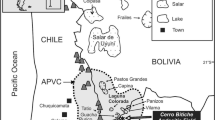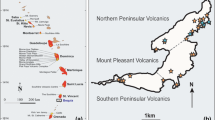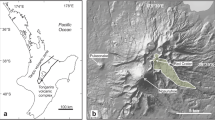Abstract
Volcán Tequila is an extinct stratovolcano in the western Mexican Volcanic Belt that has erupted lavas ranging from andesite to rhyolite during the last 0.9 Ma. Following an early period of rhyolitic volcanism, the main edifice of the volcano was constructed by central vent eruptions that produced ∼ 25 km3 of pyroxene-andesite. At about 0.2 Ma central activity ceased and numerous flows of hornblende-bearing andesite, dacite, and rhyodacite erupted from vents located around the flanks of the volcano. Bimodal plagioclase phenocryst rim compositions in lavas from both the main edifice and the flanks indicate that magma mixing commonly occurred shortly prior to or during eruption. Compositions of endmember magmas involved in mixing, as constrained by whole-rock major and trace element abundances, phenocryst compositions, and mineral-melt exchange equilibria, are similar to those of some lavas erupted from the central vent and on the flanks of the volcano. Estimated pre-eruptive temperatures for hornblende-bearing lavas (970°–830°C) are systematically lower than for lavas that lack hornblende (1045°–970°C), whereas magmatic H2O contents are systematically higher for hornblende-bearing lavas. In addition to stabilizing hornblende, high magmatic water contents promoted crystallization of calcic plagioclase (An70–82). Frequent injections of magma into the base of the subvolcanic plumbing system followed by eruption of mixed magma probably prevented formation of large volumes of silicic magma, which have caused paroxysmal, caldera-forming eruptions at other stratovolcanoes in western Mexico. The later stages of volcanic activity, represented by the flank lavas, indicate a change from a large magma storage reservoir to numerous small ones that developed along a NW-trending zone parallel to regional fault trends. Sr and Nd isotopic data for lavas from the Tequila region and other volcanoes in western Mexico demonstrate that differentiated calc-alkaline magmas are formed primarily through crystal fractionation of mantle-derived calc-alkaline basalt coupled with assimilation of crustal material.
Similar content being viewed by others
References
Allan JF, Nelson SA, Luhr JF, Carmichael ISE, Wopat M, Wallace PJ (1991) Pliocene-Recent rifting in SW Mexico and associated volcanism: an exotic terrain in the making. Mem Am Assoc Pet Geol 47:425–445
Anderson AT Jr (1976) Magma mixing: petrological process and volcanological tool. J Volcanol Geotherm Res 1:3–33
Anderson AT Jr (1984) Probable relations between plagioclase zoning and magma dynamics, Fuego Volcano, Guatemala. Am Mineral 69:660–676
Bacon CR (1985) Implications of silicic vent patterns for the presence of large crustal magma chambers. J Geophys Res 90:11243–11252
Bacon CR, Druitt TH (1988) Compositional evolution of the zoned calcalkaline magma chamber of Mount Mazama, Crater Lake, Oregon. Contrib Mineral Petrol 98:224–256
Bacon CR, Hirschmann MM (1988) Mg/Mn partitioning as a test for equilibrium between coexisting Fe−Ti oxides. Am Mineral 73:57–61
Baker DR, Eggler DH (1987) Compositions of anhydrous and hydrous melts coexisting with plagioclase, augite, and olivine or low-Ca pyroxene from 1 atm to 8 kbar: application to the Aleutian volcanic center of Atka. Am Mineral 72:12–28
Brey GP, Köhler T (1990) Geothermometry in four-phase lherzolites II. New thermobarometers, and practical assessment of existing thermobarometers. J Petrol 31:1353–1378
Campa MF, Coney PJ (1983) Tectonostratigraphic terranes and mineral resource distributions in Mexico. Can J Earth Sci 20:1040–1051
Carmichael ISE (1967) The iron-titanium oxides of salic volcanic rocks and their associated ferromagnesian silicates. Contrib Mineral Petrol 14:36–64
Centeno-García E, Ruíz J, Coney PJ, Patchett PJ, Ortega-Gutiérrez F (1993) Guerrero terrane of Mexico: its role in the Southern Cordillera from new geochemical data. Geology 21:419–422
DeMets C, Stein S (1990) Present-day kinematics of the Rivera Plate and implications for tectonics in southwestern Mexico. J Geophys Res 95:21,931–21,948
Demant A (1979) Vulcanologia y petrografia del sector occidental del eje neovolcanico. UNAM Inst Geol Revista 3:39–57
DePaolo DJ (1981) A neodymium and strontium isotopic study of the Mesozoic calc-alkaline granitic batholiths of the Sierra Nevada and Peninsular Ranges, California. J Geophys Res 86:10470–10488
Donovan JJ, Rivers ML, Armstrong JT (1992) PRSUPR: automation and analysis software for wavelength dispersive electron-beam microanalysis on a PC. Am Mineral 77:444–445
Drummond KJ (ed) (1981) Plate tectonic map of the circum-Pacific region: northeast quadrant. Am Assoc Pet Geol, Tulsa, Oklahoma
Dungan MA, Rhodes JM (1978) Residual glasses and melt inclusions in basalts from DSDP legs 45 and 46: evidence for magma mixing. Contrib Mineral Petrol 67:417–431
Ericson J, Kimberlin J (1977) Obsidian sources, chemical characterization and hydration rates in west Mexico. Archaeometry 19:157–166
Frost TP, Mahood GA (1987) Field, chemical, and physical constraints on mafic-felsic magma interaction in the Lamacrk Granodiorite, Sierra Nevada, California. Geol Soc Am Bull 99:272–291
Gerlach DC, Grove TL (1982) Petrology of Medicine Lake Highland volcanics: characterization of endmembers of magma mixing. Contrib Mineral Petrol 80:147–159
Ghiorso MS, Sack RO (1991) Fe−Ti oxide geothermometry: thermodynamic formulation and the estimation of intensive variables in silicic magmas. Contrib Mineral Petrol 108:485–510
Gill JB (1981) Orogenic andesites and plate tectonics. Springer, Berlin
Gilbert CM, Mahood GA, Carmichael ISE (1985) Volcanic stratigraphy of the Guadalajara area, Mexico. Geofisica Internacional, v 24, pp 169–191
Grove TL, Gerlach DC, Sando TW (1982) Origin of calc-alkaline series lavas of Medicine Lake volcano by fractionation, assimilation and mixing. Contrib Mineral Petrol 80:160–182
Harris JM (1986) Silicic volcanics of Volcán Tequila, Jalisco, Mexico. MS thesis, University of California
Hasenaka T, Carmichael ISE (1985) The cinder cones of Michoacán-Guanajuato, central Mexico: their age, volume and distribution, and magma discharge rate. J Volcanol Geotherm Res 25:105–124
Housh TB, Luhr JF (1991) Plagioclase-melt equilibria in hydrous systems. Am Mineral 76:477–492
Huppert HE, Sparks RSJ, Turner JS (1982) Effects of volatiles on mixing in calc-alkaline magma systems. Nature 297:554–557
Karttunen F (1983) An analytical dictionary of Náhuatl. University of Texas Press, Austin, Texas
Klitgord KD, Mammerickx J (1982) Northern East Pacific Rise: magnetic anomaly and bathymetric framework. J Geophys Res 87:6725–6750
Kress VC, Carmichael ISE (1991) The iron redox state in silicate liquids: the effect of pressure, temperature, oxygen fugacity and composition, with application to the genesis of basic magma. Contrib Mineral Petrol 108:82–92
Kuno H (1950) Petrology of Hakone volcano and the adjacent areas, Japan. Geol Soc Am Bull 61:957–1019
Lofgren G (1974) An experimental study of plagioclase crystal morphology: isothermal crystallization. Am J Sci 274:243–273
Luhr JF (1978) Factors controlling the evolution of the prehistoric, pyroclastic eruption of Volcán San Juan. Geol Soc Am Abstr Prog 10:114
Luhr JF (1990) Experimental phase relations of water- and sulfursaturated arc magmas and the 1982 eruptions of El Chichón volcano. J Petrol 31:1071–1114
Luhr JF (1992) Slab-derived fluids and partial melting in subduction zones: insights from two contrasting Mexican volcanoes (Colima and Ceboruco). J Volcanol Geotherm Res 54:1–18
Luhr JF, Carmichael ISE (1980) The Colima volcanic complex, Mexico: I. Post-caldera andesites from Volcán Colima. Contrib Mineral Petrol 71:343–372
Luhr JF, Carmichael ISE (1982) The Colima volcanic complex, Mexico: III. Ash- and scoria-fall deposits from the upper slopes of Volcán Colima. Contrib Mineral Petrol 80:262–275
Luhr JF, Carmichael ISE (1985) Jorullo Volcano, Michoacan, Mexico (1759–1774): the earliest stages of fractionation in calcalkaline magmas. Contrib Mineral Petrol 90:142–161
Luhr JF, Prestegaard KL (1988) Caldera formation at Volcán Colima, Mexico, by a large Holocene volcanic debris avalanch. J Volcanol Geotherm Res 35:335–348
Luhr JF, Nelson SA, Allan JF, Carmichael ISE (1985) Active rifting in southwestern Mexico: manifestations of an incipient eastward spreading ridge jump. Geology 13:54–57
Luhr JF, Allan JF, Carmichael ISE, Nelson SA, Hasenaka T (1989) Primitive calc-alkaline and alkaline rock types from the Western Mexican Volcanic Belt. J Geophys Res 94:4515–4530
Mahood GA (1980) Geological evolution of a Pleistocene rhyolitic center-Sierra La Primavera, Jalisco, Mexico. J Volcanol Geotherm Res 8: 199–230
Mahood GA, Halliday AN (1988) Generation of high-silica rhyolite: a Nd, Sr, and O isotopic study of Sierra La Primavera, Mexican neovolcanic belt. Contrib Mineral Petrol 100:183–191
Miyashiro A (1974) Volcanic rock series in island arcs and active continental margins. Am J Sci 274:321–355
Moorbath S, Thorpe RS, Gibson IL (1978) Strontium isotope evidence for petrogenesis of Mexican andesites. Nature 271:437–438
Muria JM (1982) Historia de Jalisco. Secretaria General, Gobierno de Jalisco, Guadalajara, Mexico
Nelson SA (1980) Geology and petrology of Volcán Ceboruco, Nayarit, Mexico. Geol Soc Am Bull 91:2290–2431
Nelson SA (1986) Volcanological field trip to the western end of the Mexican Volcanic Belt. Geol Assoc Canada
Nelson SA, Livieres RA (1986) Contemporaneous calc-alkaline and alkaline volcanism at Sangangüey Volcano, Nayarit, Mexico. Geol Soc Am Bull 97:798–808
Nieto-Obregón J, Argote LA, Damon PE (1985) Geochronologic, petrologic, and structural data related to large morphologic features between the Sierra Madre Occidental and the Mexican Volcanic Belt. Geofisica Internacional 24:623–663
Nixon GT (1982) The relationship between Quaternary volcanism in Central Mexico and the seismicity and structure of subducted ocean lithosphere. Geol Soc Am Bull 93:514–523
Nixon GT (1988) Petrology of the younger andesites and dacites of Iztaccihuatl volcano, Mexico: I. Disequilibrium phenocryst assemblages as indicators of magma chamber processes. J Petrol 29:213–264
Nixon GT, Demant A, Armstrong RL, Harakal JE (1987) K−Ar and geologic data bearing on the age and evolution of the Trans-Mexican Volcanic belt. Geofisica Internacional 26:109–158
Pardo M, Suárez G (1993) Steep subduction geometry of the Rivera plate beneath the Jalisco block in western Mexico. Geophys Res Lett 20:2391–2394
Robin C, Camus G, Gourgaud A (1991) Eruptive and magmatic cycles at Fuego de Colima volcano (México). J Volcanol Geotherm Res 45:209–225
Rutherford MJ, Devine JD (1988) The May 18 1980, eruption of Mount St. Helens 3. Stability and chemistry of amphibole in the magma chamber. J Geophys Res 93:11949–11959
Rutherford MJ, Sigurdsson H, Carey S, Davis A (1985) The May 18 1980, eruption of Mount St. Helens 1. Melt composition and experimental phase equilibria. J Geophys Res 90:2929–2947
Siebert L (1984) Large volcanic debris avalanches: characteristics of source areas, deposits, and associated eruptions. J Volcanol Geotherm Res 22:163–197
Sisson TW, Grove TL (1993) Experimental investigations of the role of H2O in calc-alkaline differentiation and subduction zone magmatism. Contrib Mineral Petrol 113:143–166
Sparks RSJ, Marshall L (1986) Thermal and mechanical constraints on mixing between mafic and silicic magmas. J Volcano Geotherm Res 29:99–124
Sparks RSJ, Sigurdsson H, Wilson L (1977) Magma-mixing: a mechanisms for triggering acid explosive eruptions. Nature 267:315–318
Stoopes GR, Sheridan MF (1992) Giant debris avalanches from the Colima Volcanic Complex, Mexico: implications for longrunout landslides (>100 km) and harzard assessment. Geology 20:299–302
Trombold CD, Luhr JF, Hasenaka T, Glascock MD (1993) Chemical characteristics of obsidian from archaeological sites in western Mexico and the Tequila source area: implications for regional and pan-regional interaction within the northern Mesoamerican periphery. Ancient Mesoamerica 4:255–270
Tsuchiyama A (1985) Dissolution kinetics of plagioclase in the melt of the system diopside-albite-anorthite, and origin of dusty plagioclase in andesites. Contrib Mineral Petrol 89:1–16
Tsuchiyama A (1986) Experimental study of olivine-melt reaction and its petrological implications. J Volcanol Geotherm Res 29:245–264
Urrutia-Fucugauchi J, Molina-Garza RS (1992) Gravity modelling of regional crustal and upper mantle structure of the Guerrero terrane, I. Colima graben and southern Sierra Madre Occidental, western Mexico. Geofisica Internacional 31:493–507
Verma S, Luhr JF (1993) Sr−Nd−Pb isotope and trace element geochemistry of calc-alkaline andesites from Volcán Colima. Geofísica Internacional 32:617–631
Verma S, Nelson SA (1989) Isotopic and trace element constraints on the origin and evolution of alkaline and calc-alkaline magmas in the northwestern Mexican volcanic belt. J Geophys Res 94:4531–4544
Walker D, Shibata T, DeLong SF (1979) Abyssal tholeiites from the Oceanographer Fracture Zone II. Phase equilibria and mixing. Contrib Mineral Petrol 70:111–125
Wallace P, Carmichael ISE, Righter K, Becker TA (1992) Volcanism and tectonism in western Mexico: a contrast of style and substance. Geology 20:625–628
Wells PRA (1977) Pyroxene thermometry in simple and complex systems. Contrib Mineral Petrol 62:129–139
White WM, Hofmann AW (1982) Sr and Nd isotope geochemistry of oceanic basalt and mantle evolution. Nature 296:821–825
Wopat MA (1990) Quaternary alkaline volcanism and tectonics in the Mexican Volcanic Belt near Tequila, Jalisco, southwestern Mexico. PhD dissertation, University of California
Author information
Authors and Affiliations
Additional information
Present Address:Department of the Geophysical Sciences The University of Chicago, Chicago IL, 60637, USA
Rights and permissions
About this article
Cite this article
Wallace, P.J., Carmichael, I.S.E. Petrology of Volcán Tequila, Jalisco, Mexico: disequilibrium phenocryst assemblages and evolution of the subvolcanic magma system. Contr. Mineral. and Petrol. 117, 345–361 (1994). https://doi.org/10.1007/BF00307270
Received:
Accepted:
Issue Date:
DOI: https://doi.org/10.1007/BF00307270




